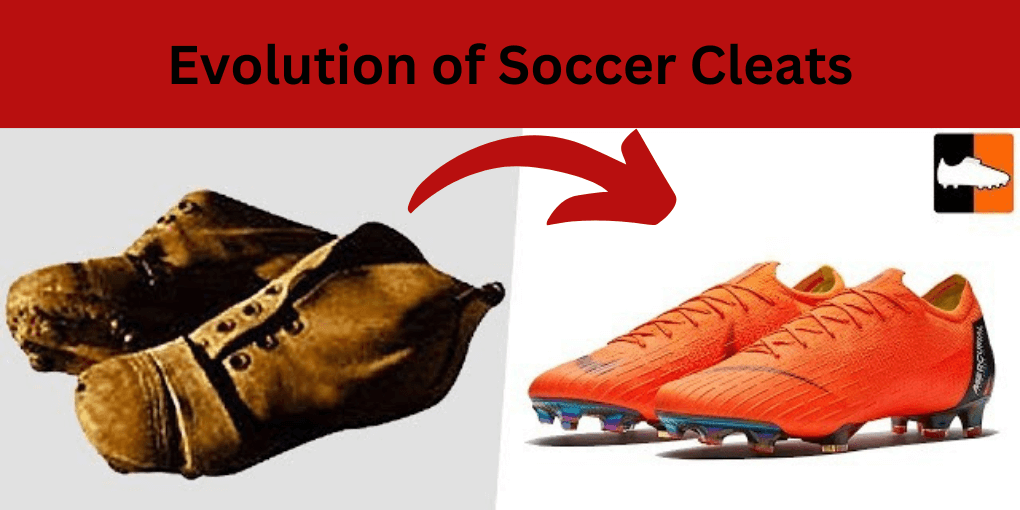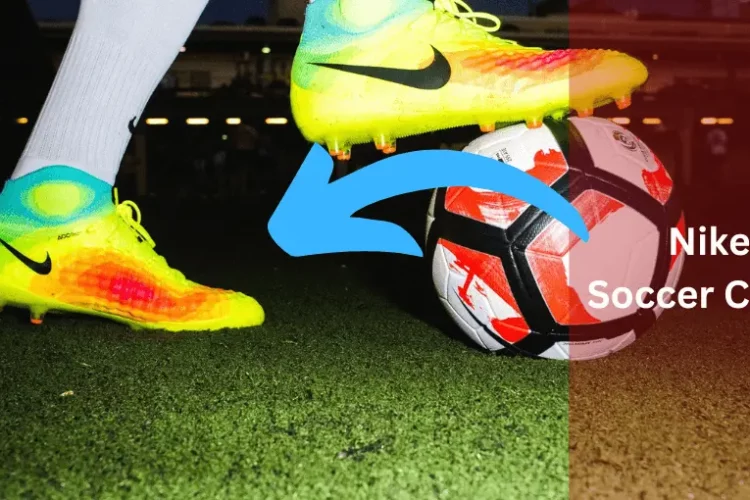The Evolution of Soccer Cleats: A Historical Perspective
Once the legendary Pelé said, “To be a great footballer, the very first condition is to be fast in thought and decision.”

Did you know that in the early days, soccer players wore cleats that were more like heavy boots? Can you imagine trying to score a goal in those? I can’t.
I was curious about the evolution of soccer cleats and did some study to find out the actual journey of these cleats over decades.
The result amazed me, and I’m sure you’ll be thrilled by these magical transformations too.
So, are you ready to uncover the secrets behind the footwear that has shaped this beautiful game? Let’s discover together how they emerged and got updated over time.
Early Beginnings of Soccer Cleats
Legendary soccer player Sir Stanley Matthews once said, “In my day, we didn’t have these fancy boots. We just played in whatever we could find!”
This shows the evaluation of soccer cleats over time. Here, I’m giving you an overview of the early days of soccer cleats:
- Primitivenings: In the beginning, players didn’t have specialized cleats in the game. People played barefoot or wore simple shoes made of animal hides or other materials. These early shoes provided very little protection and traction on the field.
- Heavy Boots, Slow Moves: These early soccer boots were really heavy at that time. The players had to move carefully and make quick turns on the field, which was quite tough for them.
- Adaptation of Footwear: As the popularity of soccer grew, players started modifying their footwear to make it suitable for the game. Some players added nails or small studs to their shoes to gain a better grip on the grass. These makeshift cleats helped improve their traction. But it was still far from the advanced designs we have today.
- Numbers and Fun Facts: In the early 1900s, soccer cleats were so basic that they didn’t even have numbers or cool names like they do today. As a result, soccer games used to have way fewer goals compared to today’s exciting matches.
1900s: The Leather Era of Soccer Cleats
If you want to know about the evolution of soccer cleats, it’s important to start from the beginning. Here, I’m talking about the 1900s, when the leather era of soccer cleats started.
Introduction of the Leather Era
In the early 1900s, soccer cleats entered their “Leather Era.” During this period, leather became the primary material used for making soccer cleats.
Leather cleats were known for their durability and flexibility. It could also mold to the shape of the player’s foot.
Leather Construction
These were made of high-quality leather, such as kangaroo or cowhide. Manufacturers choose this leather for its ability to resist the rough conditions of the game.
Durability and Protection
These offered excellent durability, which allowed players to use them season after season. The sturdy material protected the players against injury and harsh weather.
Natural Flexibility
Leather cleats were famous for their natural flexibility and ability to fit the shape of the player’s foot.
This provided a comfortable fit and allowed for better control on the field. Over time, the leather would soften and mold to the foot of the player, by creating a personalized fit.
Evolving Designs
During the Leather Era, cleat designs advanced in stud patterns and sole configurations. They used conical studs to provide stability on the grassy playing surfaces.
Cleats started having stronger front parts to last longer and protect against kicks and hits.
Legacy and Endurance
The leather era marked a significant period of long-lasting and strong legacy. Some famous players of the time, like Sir Stanley Matthews, did well in leather cleats and made a lasting impact on the game.
Like him, many other players did great things while wearing leather cleats. This inspired future generations of soccer players to follow their path.
1950s-1970s: Technological Advancements of Soccer Cleats
In the days of disco music and colorful outfits, soccer cleats were getting a tech upgrade. You guessed it right. I’m talking about the time from the 1950s to the 1970s.
- Introduction of Synthetic Materials: Synthetic materials, such as nylon and polyurethane, started being used to make soccer cleats. These materials offered increased durability, a lighter weight, and better water resistance than the old leather ones.
- Screw-In Cleats Hit the Scene: Did you know that by the 1970s, millions of these cleats were sold worldwide? During this time, cleats with screw-in studs became super popular. So, it won’t be wrong if you think of it as a soccer-cleat revolution.
- Increased Comfort and Cushioning: In the 1950s, the manufacturers started using better cushioning materials in cleats. They used EVA foam or air pockets to enhance comfort and reduce pressure on the feet. This innovation helped reduce injuries and provided players comfort during games.
- Colors and Styles: By the late ’60s, they became fashionable among the players too. So, players could choose soccer cleats from a variety of colors and designs.
- Adidas and the World Cup Connection: Adidas, the giant in the soccer cleat game, introduced the Copa Mundial in 1954. It became one of their best-selling soccer cleats ever.
- Pelé and His Puma Prowess: When Pelé wore his Puma cleats during the 1970 World Cup, it wasn’t only about style. It was about making history. Those cleats helped him score amazing goals that we still talk about today.
1990s: The Lightweight Revolution of Soccer Cleats
Soccer player Michael Owen, who wore those fast Nike Mercurial shoes, amazed everyone with his quick moves on the field.
Did you know he won the Ballon d’Or in 2001, proving how much these light shoes could make players shine? So, let’s see the lightweight revolution of soccer cleats in the 90s:
- Introduction: The 1990s marked a significant period in the evolution of soccer cleats. Manufacturers focused on lightweight design and technological innovation. So, these cleats became faster and cooler than before.
- Lightweight Materials: Cleat manufacturers began using lightweight synthetic materials. They used microfiber, or mesh, to reduce the overall weight of the cleats. These materials provided players with a greater level of speed on the field.
- Enhanced Breathability: Introducing breathable materials and mesh panels in soccer cleats improved airflow. This helped keep players’ feet cool and dry during intense matches. It also reduces the risk of discomfort, blisters, and foot odor.
- Advanced Stud Configurations: Cleats in the 1990s featured advanced stud configurations too. For example, bladed or triangular-shaped studs. These new stud designs offered improved traction and stability on various playing surfaces. The little bumps on the bottom of the cleats gave a better grip and reduced the risk of players getting hurt from slipping.
- Customized Fit: Some companies started using fancy ways to tie shoes. They also used some special features. It allowed players to change them according to their comfort. It provided a snug and secure fit for the players’ feet. As a result, it enhanced their performance and reduced the risk of slippage or discomfort.
- Supports and Iconic Cleats: Famous soccer players, like Ronaldo and Zinedine Zidane, played a significant role in shaping the lightweight revolution in soccer cleats. Their collaborations with cleat manufacturers helped make soccer cleats even better.
2000s: Customization and Performance Enhancement of Soccer Cleats
The 2000s brought about a new era of soccer cleats. It focused on customization and performance enhancement.
Shoemakers came up with cool ideas that let players make their shoes special for more comfort and better playing. Let’s see how this era contributed to the evolution of soccer cleats:
Customized Color and Design Options
In this era, cleat manufacturers offered a wide range of color and design options. So, players could choose their favorite colors or even personalize their cleats with their names or team logos.
Personalized Fit
These cleats started to have advanced lacing systems, Velcro straps, and customizable options. This allowed players to adjust the fit of their cleats according to their preference and playing style.
Enhanced Traction Systems
Cleat companies developed advanced traction systems, such as blade-shaped or multidirectional studs.
These designs provided a better grip on various playing surfaces. So, it allowed players to make quick and precise movements.
Innovative Materials
In the 20s, they started using new materials in cleat construction. For example, carbon fiber and lightweight synthetics.
These materials offered improved performance, greater speed, and durability.
Improved Shock Absorption
Cleat manufacturers also focused on enhancing protection and shock absorption properties.
This reduced the impact on players’ feet during intense movements. As a result, it minimized the risk of injuries and improved their comfort.
Performance Tracking Technology
Some cleats had technologies that tracked and analyzed players’ performance metrics. For example, they could study the speed, distance, and even the striking power of the players.
These features allowed players to check their performance and make adjustments to improve their game.
Collaboration with Athletes
Shoemakers worked together with professional soccer players to make special cleats for them. These collaborations helped them to make cleats to make players do better by using the ideas of the best players.
The 2010s: The Fusion of Style and Technology in Soccer Cleats
Now, it is time to delve into the fusion of style and technology in soccer cleats.
- Entering the 2010s: This time has a significant impact on the evolution of soccer cleats. Shoemakers created cleats that are not only shoes but also a perfect blend of styles.
- Colorful Explosion: They created cleats with different colors and designs. It made the soccer field look like a vibrant playground.
- Adaptive Cleats for Different Players: Cleats became smart by adapting to different playing styles. Some cleats were designed for speed, while others focused on enhancing the control of the players.
- Dynamic Collars: Cleats introduced dynamic collars that felt like cozy socks around your ankles. The Nike Mercurial Superfly became a new level of comfort and style for the players.
- Eco-Friendly Cleats: At that time, soccer cleats became eco-friendly. Many brands have started using recycled materials to reduce waste. They started creating cleats with a smaller carbon footprint.
- Enhanced Ball Control: These cleats were designed to improve ball control too. For example, textured upper materials or ‘knit’ constructions. These features allowed players to have better control when passing and shooting the ball.
Current Trends in Soccer Cleats
As we explore the evolution of soccer cleats, it’s important to notice the current trends that are shaping shoes today. Let’s take a look at some of the latest developments in soccer cleats.
- Lightweight and Flexible Designs: Cleat manufacturers continue to focus on creating lightweight and flexible cleats. These cleats allow you to have greater speed and agility on the field.
- Integration of Technology: Cleats now incorporate advanced technologies to enhance performance. Some cleats feature sensors and trackers that track speed, distance, and power. It allows you to analyze and improve your performance.
- Enhanced Comfort and Fit: Cleat manufacturers are prioritizing comfort and fit. They’re designing cleats to match your foot shape. So, it reduces discomfort and improves your performance.
- Innovative Upper Materials: Cleats today feature innovative upper materials like mesh, knits, and synthetic fibers. These materials offer you better breathability, flexibility, and durability.
- Customization Options: You can now personalize your cleats with customized colors, designs, and even your names. This allows you to showcase your styles and preferences on the field.
Conclusion
To conclude, the evolution of soccer cleats shows the continuous improvement in cleats technology. Haven’t you already been thrilled by its journey? It shows the continuous improvement in footwear technology.
From the lightweight revolution to the fusion of style and technology, soccer cleats have come a long way.
So, whether you’re a new or old player, these cleats are always there to boost your game. They also help you unleash your skills and enjoy soccer to the fullest.
So, lace up your cleats, embrace the evolution, and let your talent shine on the pitch.
FAQs
Soccer cleats are super popular now. Millions of people are buying the latest styles by matching their playing styles.
It began in the 1990s. Cleats like the Nike Mercurial added speed and a burst of colors to the game. It was a magical transformation for these cleats.
Yes, different playing surfaces need different types of cleats. You can choose your cleats based on the playground where you're playing.
Yes, players like Cristiano Ronaldo and Lionel Messi have their own special cleats.


